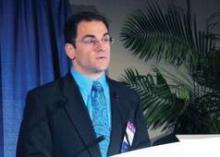CHICAGO – For patients undergoing allogeneic bone marrow transplantation, conditioning with busulfan and fludarabine followed by post-transplant graft-vs.-host disease prophylaxis with single-agent cyclophosphamide is safe and is associated with good event-free and overall survival, said investigators at the annual meeting of the American Society of Clinical Oncology.
In a study of 92 patients with high-risk leukemias or myeloid malignancies, 2-year overall survival was 67%, and the rate of grade 3 or 4 acute graft-vs.-host disease (GVHD) was 15%, comparable to that seen with busulfan-cyclophosphamide conditioning regimens, said Dr. Christopher G. Kanakry, a medical oncologist at the Sidney Kimmel Cancer Center at John Hopkins Medical Center in Baltimore.
Chronic GVHD was seen in 14% of all patients, occurring in only 7% of patients with related donors, and 22% of those with unrelated donors (P = .041). Event-free survival at 2 years was 62% and did not differ by donor type, Dr. Kanakry said.
"Post-transplant single-agent GVHD prophylaxis can be safely and effectively combined with busulfan/fludarabine myeloablative conditioning and is associated with an acceptable incidence of grade 2-4 acute graft-vs.-host disease, a low incidence of grade 3-4 acute graft-vs.-host disease and chronic graft-vs.-host disease, low treatment-related mortality, and effective disease control with favorable event-free and overall survival," he said.
Dr. Kanakry and his colleagues at Johns Hopkins, the Fred Hutchinson Cancer Center in Seattle and the University of Texas MD Anderson Cancer Center in Houston combined efforts to see whether the clinical efficacy seen in single-center studies with busulfan/fludarabine conditioning and cyclophosphamide GVHD prophylaxis could be safely combined.
They enrolled patients with high-risk hematologic malignancies, including patients with acute myeloid leukemia (AML) or acute lymphocytic leukemia in first complete remission with high-risk features, acute leukemias in second or greater remission, refractory or relapsed AML with 10% or fewer bone marrow blasts, myelodysplastic syndrome with high-risk features, chronic myeloid leukemia beyond the first chronic phase or resistant to tyrosine kinase inhibitors, Philadelphia chromosome–negative myeloproliferative disorders, relapsed chemotherapy-sensitive Hodgkin or non-Hodgkin lymphoma, or stage III multiple myeloma.
Of the 92 patients enrolled, 45 had related donors and 47 had unrelated donors.
Grade 2-4 acute GVHD occurred in 51% of patients, 42% of those with related donors, and 60% with unrelated donors (P = .027). Chronic GVHD occurred in six patients (14%), three of whom had bronchiolitis obliterans syndrome. The incidence of chronic GVHD also was significantly higher among patients with unrelated donors (P = .041).
Among all patients, 9% died from nonrelapse causes within the first 100 days of transplant, and 16% died within 1 year. There was no difference in the incidence of nonrelapse mortality between related and unrelated donors.
Not surprisingly, patients with complete remissions had significantly better 2-year event-free survival, at 80%, compared with 50% for patients with minimal residual disease, and 33% for patients with active disease (P = .0005).
Overall 2-year survival for all patients was 67% and did not differ by donor type. Overall survival was significantly better for patients with complete remissions, 79% of whom were alive at 2 years, compared with 50% of those with minimal residual disease, and 54% of those with active disease (P = .019).
Invited discussant Dr. Marcos J.G. De Lima, a hematologist-oncologist at University Hospitals Case Western Medical Center in Cleveland noted that the regimen is relatively simple, comparatively inexpensive, and reproducible.
"Could a cynic say that less chronic GVHD was due to the fact that you were using bone marrow only? I don’t think so, but certainly there is a bone marrow component [to the GVHD results]," he said.
The investigators also did not determine whether patients had ever taken other immunosuppressants, such as calcineurin inhibitors, Dr. De Lima said,
"I want to remind you folks that one of the most frustrating things in our business is that even when we reduce the incidence of acute GVHD, very few strategies have translated into less chronic [GVHD]; it’s like there is a different life between acute and chronic GVHD, and here it’s almost the opposite, which is very intriguing," he said.
The study was supported by Otsuka Pharmaceuticals. Dr. Kanakry reported having no relevant disclosures. Dr. De Lima was a coauthor of the study. He disclosed receiving research funding from Celgene.

